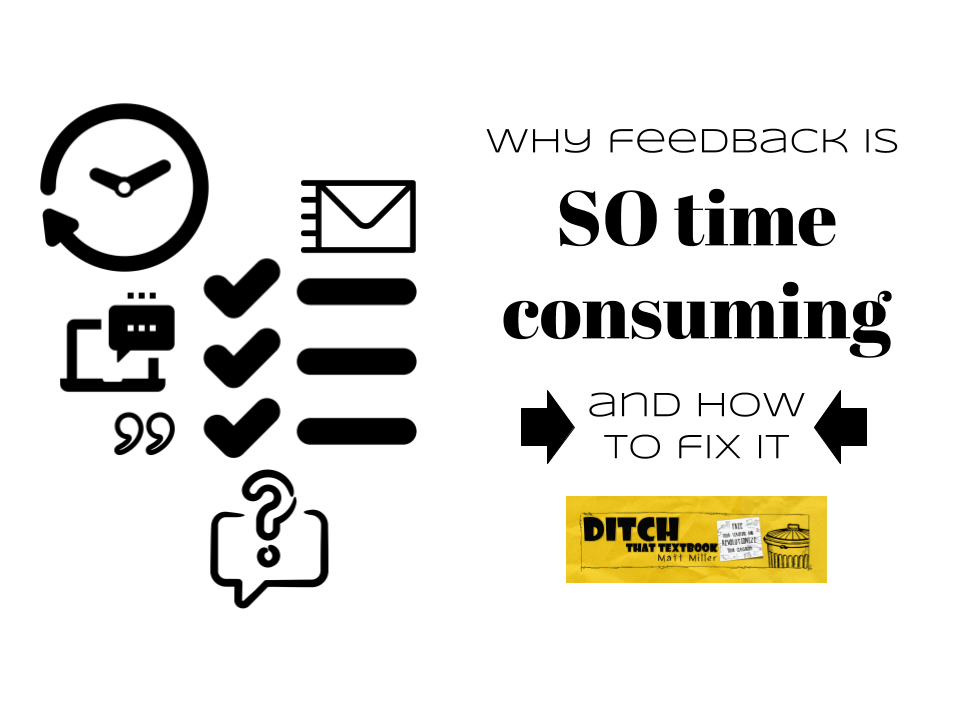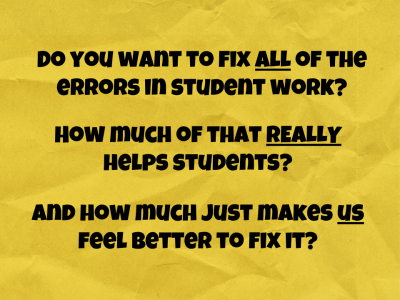

Providing feedback can take SO much effort. Here are some ways to get better feedback results in less time.
Tell me if this sounds familiar. You’re chained to your desk grading papers. It’s getting monotonous, but you feel like you need to do it because it’s important.
You hand those papers back to the students, and where do they end up? Yep, the trash.
(Even if you make them keep that homework in a binder or a folder to turn in later, you know they’re still probably not looking at those papers, right?)
What we think we’re doing here is providing meaningful, important feedback to our students.
Feedback can be meaningful. It IS important.
But sometimes, the way that we do it stinks.
It may be good to get to the “why” of the issue first. Why do put so much effort into this?
Because it works.
Here are some concrete ideas you can start using right away …
There’s no shame in this! I’ve heard Alice Keeler, my Ditch That Homework co-author, put it this way: If a computer can grade it, it should.
Likely, not everything students do for us is at the top of Bloom’s Taxonomy. We still have to build through the basics before getting to the highest levels of critical thinking. And that’s OK.
As we do that, here are some ways to provide automated basic feedback:
There’s a bit of a stigma around automated feedback. Some teachers think it’s not real teaching. Or it’s lazy.
It’s not the single, perfect solution to providing feedback. However …
“But it takes so much time to set up automated feedback! I don’t have that kind of time.”
I get that. But how long does it take you to do traditional grading? Set up automated grading ONCE and see how long it takes. Then see how much time it saves you in the long run — and the impact on students.
Teachers are fixers.
We see errors in student work. Mistakes. Flaws in logic. And we want to fix them.
 At some point, it’s not helping students anymore.
At some point, it’s not helping students anymore.
Sometimes, we fix ALL of the errors in student work because it makes US feel better. Let’s admit it.
It’s like seeing two seconds left on the microwave timer. Or when someone doesn’t tear all of the paper towel and leaves a corner.
Gotta fix it.
When students see all of our fixing, it can cause overwhelm. This isn’t because students are soft or inattentive, either.
It’s based in cognitive load theory. It basically says that your working memory has limits … that you can only think about so many things before your brain throws up its arms and says, “I’m done!”
Here’s what we miss about this in the classroom …
Students load up their brains with LOTS of things before they even set foot in the classroom. And those count toward their cognitive load, too.
When you hand back student work and it’s dripping in red ink, there’s only so much of that “feedback” that students will process and retain.
If they’re like me, it might cause them to start to question themselves and their entire abilities in the class. Our goal with feedback is to help students improve. This is debilitating instead of empowering.
Dumping tons of comments and corrections on students all at once doesn’t help anyone.
It’s overwhelming and counter-productive for students. It is time-consuming for teachers with low return investment of effort.
Let’s limit the feedback we give students to a reasonable amount to process and implement in one sitting.
Let’s talk about just one particular strategy that gets a bad rap these days. (See how I’m lessening your cognitive load here?)
Flash cards.
They’ve been around for ages. And there’s a reason for that.
They give students immediate feedback. (Was I right or wrong? The back of the flashcard tells me.)
They use retrieval practice, a powerful, brain-friendly practice backed by cognitive science. (I’ve been on a big retrieval practice kick recently.)
With a tool like Quizlet (quizlet.com), a new deck of flash cards can be created in a matter of a couple minutes (by teachers OR students). The mobile app means students can carry them in their pockets any time. Plus, they have a variety of practice activities to choose from in the app.
A couple of tiny tips for using them can reap even greater long-term memory.
Pooja Agarwal, a cognitive scientist with a K-12 background, shares cognitive science best practices on her website, RetrievalPractice.org. Some advice from her about getting the most out of flash cards:
Feedback doesn’t have to consume your life. And it can have more impact on student learning.
Thankfully, you don’t need to clear more time in your calendar to improve feedback. Grant Wiggins wrote in this ASCD publication:
Research shows that less teaching plus more feedback is the key to achieving greater learning.
And there are numerous ways — through technology, peers, and other teachers — that students can get the feedback they need.
More resources on feedback and cognitive load theory:
How do you provide feedback effectively and efficiently to students? Tell us in a comment below!
For notifications of new Ditch That Textbook content and helpful links:
Interested in having Matt present at your event or school? Contact him by e-mail!
Matt is scheduled to present at the following upcoming events:
[getnoticed-event-table scope=”upcoming” max=”15″ expanding=”false”]

Session expired
Please log in again. The login page will open in a new tab. After logging in you can close it and return to this page.